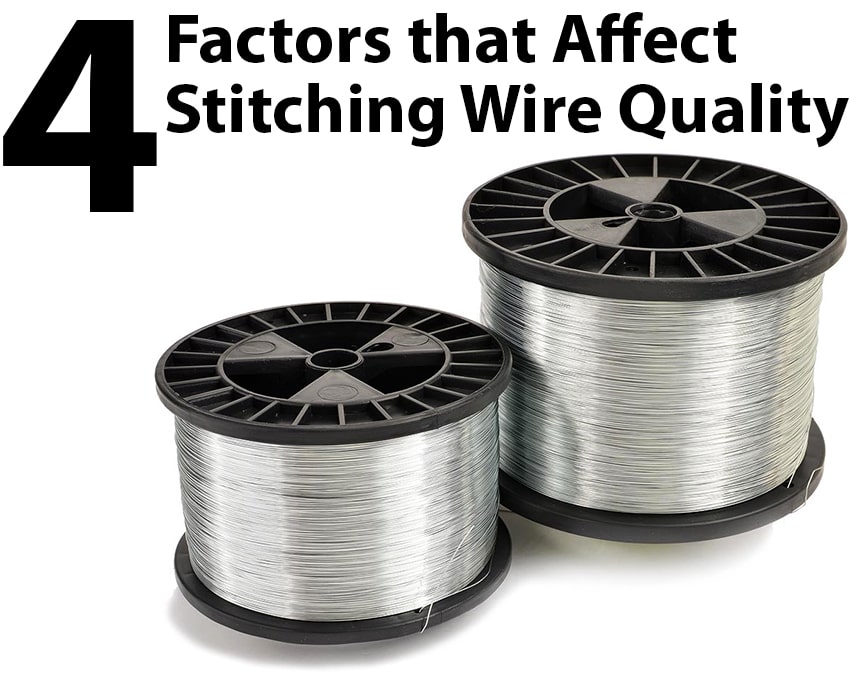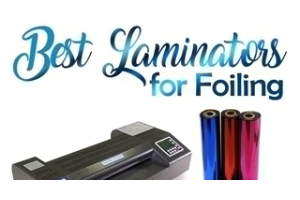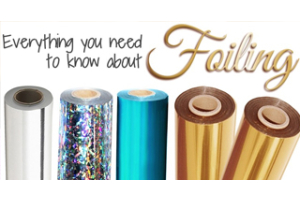4 Factors that Affect Stitching Wire Quality

When it comes to saddle stitching, there are several factors that can effect the final stitch quality. And stitch quality is important, both for the presentation factor as well as for safety to ensure no users get stuck with the sharp ends. But first, a quick overview of saddle stitching...
Commercial printing is probably the most popular industry that uses saddle stitching as a way to bind pages together. Also called stitch binding, spine-stapling, or staple binding, saddle stitching uses a spool of stitching wire that is sewn and cut into the spine of a folded booklet using a saddle stitching machine. Used for magazines, catalogs, booklet making, and so much more, saddle stitching has evolved through the years into a staple (pun intended) in the printing world.
There are four different factors that can affect your final stitch quality. Whether you are new to saddle stitching, or you have been doing it for years and are encountering some problems, this list will help you either be prepared for potential problems or troubleshoot the issue you may already be experiencing.
Factor #1: Type of Stitching Wire
Most print shops will use a chrome-finish stitching wire made of galvanized metal wire. These wires are often coated with a special friction-reducing additive that prevents peeling and flaking while making it run smoothly through your machine for seamless binding. This also helps with proper forming and bending of the wire into the finished 'staple' shape. Some machines can also handle nylon coated stitching wire (colored stitch wire), and tin wire. But not all machines can handle all types of wire, so be sure you are using a wire style that is compatible with your specific stitcher. You can check your machine user manual for the kind of compatible wires.
Factor #2: Tensile
Tensile refers to the pull that is required to break the wire from the spool, and is measures in PSI (pounds per square inch). The tensile of your stitching wire is an indicator if its quality and, generally, a higher tensile strength indicates a higher quality wire. But you don't want it to be too high, as it can wear out your machine pre-maturely. Most top-quality wires will have a tensile strength that ranges somewhere between 130,000 to 165,000 PSI. Tensile below this range mean the wire is too soft and may not properly form into a stitch, while tensile above are too hard and can damage your machine. So make sure your supplies fall somewhere within that range for the best quality stitching wire.
Factor #3: Helix
'Helix' refers to the natural curve of the wire as it is unwound from the spool. Because the wire is wrapped around a round spool, it has a natural curve to it when it is unwound as well. This radial curve is called the 'cast' and is measured as the diameter free turn of the wire. The axial component of the helix is called the 'camber' and is measured at the ends of the free-hanging wire.
Well that's a bit confusing, huh? The important thing to take from this is the ideal cast:camber ratio of your helix. What you should look for is a large cast and small camber combination for a high quality wire. This will lead to a smoother run through your stitching machine head as it will produce less drag and less mis-stitches or dropped stitches.
Factor #4: Wire Path
The path of your stitching wire is a critical component. An improper path can lead to scratching and chipping of your wire, as well as prematurely worn out parts on your stitcher. To keep your path clean, you need to ensure there are no flat spots on your guides and that your felt pad wiping system is clean.
For more information or a quote, call us at
(866) 537-2244
or email
info@buy101.com
 About the Author • Mallory Morsa has been part
of Binding101 since 2008 and she is the primary content creator for BUY101® information. She began in customer
service and sales where she honed in her skills to provide the customer with professional, fast, and accurate
information. Shortly after, she was promoted to sales supervisor and also took on the role of product expert,
training the team on new products. Throughout this time, she also wrote content for the site, as well as contributed
stock photography and videography. As the team grew, she moved to an official position as the content specialist and
social media manager. Her skills in these variety of areas give her the unique expertise to not just create content
for the web, but to create content for you, the customer. She has a Bachelor's degree in business management and
marketing, was on the Dean's List each year, and graduated Summa Cum Laude. In her free time, Mallory's favorite
things to do include volunteering at the animal shelter by bottle feeding neonatal kittens, reading at the park,
cooking plant-based meals, playing board games, hiking, and binge streaming TV shows with her furbabies and family
beside her.
About the Author • Mallory Morsa has been part
of Binding101 since 2008 and she is the primary content creator for BUY101® information. She began in customer
service and sales where she honed in her skills to provide the customer with professional, fast, and accurate
information. Shortly after, she was promoted to sales supervisor and also took on the role of product expert,
training the team on new products. Throughout this time, she also wrote content for the site, as well as contributed
stock photography and videography. As the team grew, she moved to an official position as the content specialist and
social media manager. Her skills in these variety of areas give her the unique expertise to not just create content
for the web, but to create content for you, the customer. She has a Bachelor's degree in business management and
marketing, was on the Dean's List each year, and graduated Summa Cum Laude. In her free time, Mallory's favorite
things to do include volunteering at the animal shelter by bottle feeding neonatal kittens, reading at the park,
cooking plant-based meals, playing board games, hiking, and binge streaming TV shows with her furbabies and family
beside her.











